The Economics and Statistics Division maintains archives of previous publications for accountability purposes, but makes no updates to keep these documents current with the latest data revisions from Statistics Canada. As a result, information in older documents may not be accurate. Please exercise caution when referring to older documents. For the latest information and historical data, please contact the individual listed to the right.
<--- Return to Archive
For additional information relating to this article, please contact:
March 19, 2025NOVA SCOTIA QUARTERLY POPULATION ESTIMATES AS OF JANUARY 1, 2025 
Nova Scotia's population was 1,079,627 as of January 1, 2025, a decline of 49 (-0.005%) from October 1, 2024. This is the first time Nova Scotia's population has fallen since the July to September period of 2020. The decline from October 1, 2024 to December 31, 2024, was due to a rise in exists of non-permanent residents.
From October 1 to December 31, there were positive contributions to population growth from international sources as immigration (+2,255) and net emigration (111). The number of non-permanent residents leaving Nova Scotia (-4,679) exceeded the number entering the province (+3,199) by 1,480.
Natural change continues to put downward pressure (-1,057) on Nova Scotia's population as deaths (-3,102) outpace births (+2,045).
The number people moving into from Nova Scotia to another province or territory (+2,776) exceeded the number of Nova Scotia moving away to another province (-2,432). The net interprovincial inflow of 344 was the weakest fourth quarter result since 2016.

Nova Scotia's population growth from October 1 to December 31 was the first fourth quarter decline since 2014. From October 1 to December 31, 2014, the population fell by 715, during a period when Nova Scotia's population was contracting.
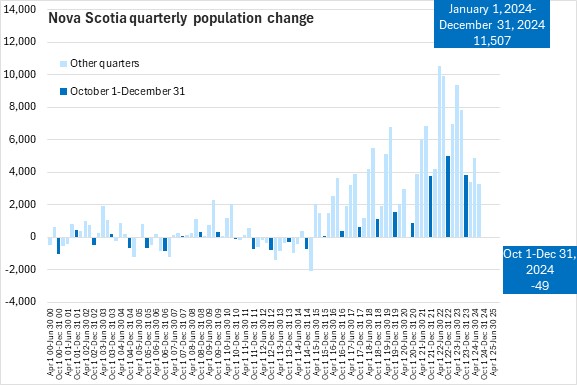
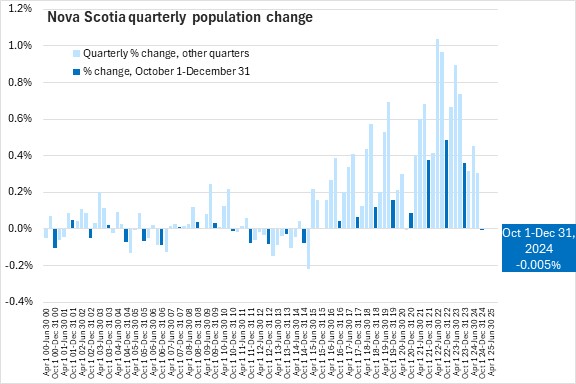
From October 1 to December 31, 2024 Nova Scotia’s population fell 0.005%, along with Newfoundland and Labrador (-0.06%) and Prince Edward Island (-0.01%). The national population grew 0.15%. Seven provinces reported increasing populations, with the fastest growth in Alberta.
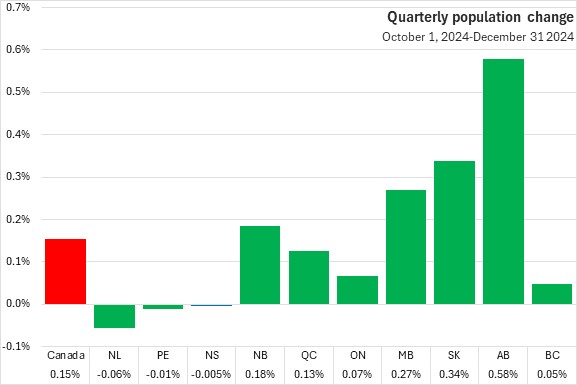
Nova Scotia's population increased by 1.08% from January 1 to December 31, 2024. This was the second slowest year-over-year population gain among provinces (ahead of Newfoundland and Labrador). Nationally, the population grew by 1.83% in the last year, with notably faster growth in Alberta.
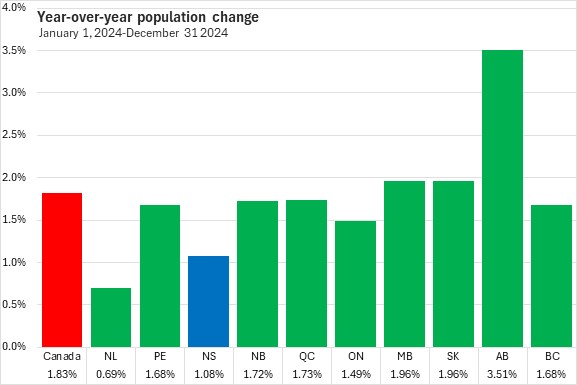
Nova Scotia's year-over-year population growth has slowed considerably from the pace reported in the previous two years.
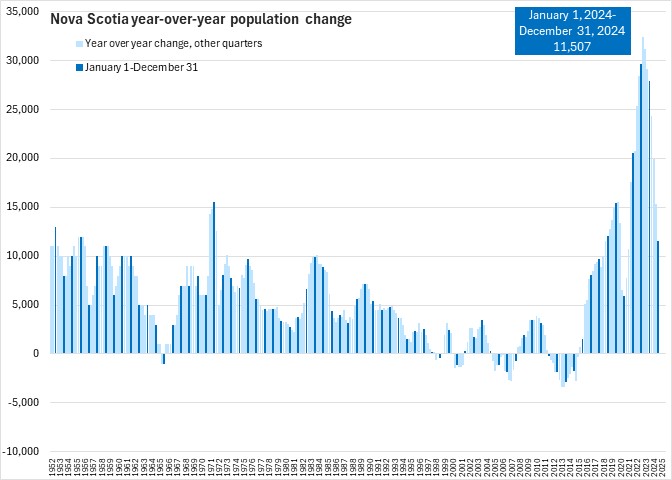
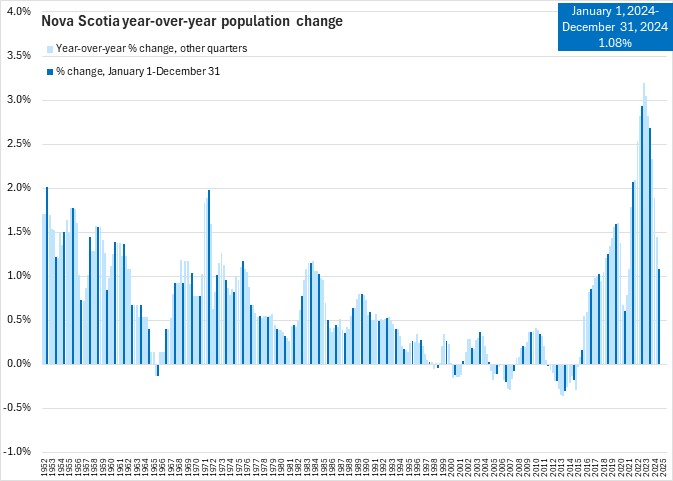
From January 1 to December 31, 2024, international sources added to the population as immigration (+14,234) was substantially higher than net emigration (495) while the number of non-permanent residents entering Nova Scotia (+18,313) exceeded the number leaving the province (-18,130) by 183.
Natural change reduced Nova Scotia's population by 4,328 as deaths (-11,954) exceeded births (+7,626).
The number people moving into Nova Scotia from another province or territory (+19,071) exceeded the number of Nova Scotia moving away to another province (-17,158) by 1,913.
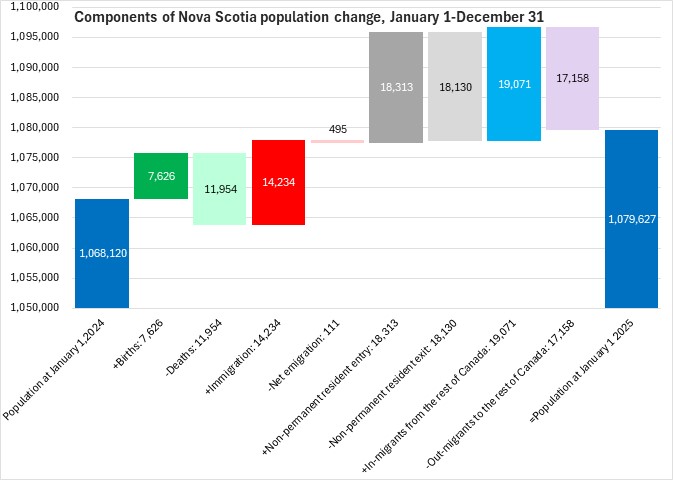
Nova Scotia’s natural population change (the number of births less the number of deaths) has been negative for several years. Between October 1 and December 31 there were 2,045 births and 3,102 deaths, amounting to a natural population decline of 1,057. The decline in the final quarter of 2024 was of similar magnitude to the two years prior.
From January 1 to December 31, 2024, there were 7,626 births, which were outnumbered by 11,954 deaths, resulting in a natural population decline of 4,328.

Immigration from other countries continued to be a strong contributor to population growth in Nova Scotia. For the period October 1 to December 31, an additional 2,255 immigrants came to the province, a deceleration from the year before. Over the past year (January 1 to December 31, 2024) 14,234 immigrants have arrived in Nova Scotia.
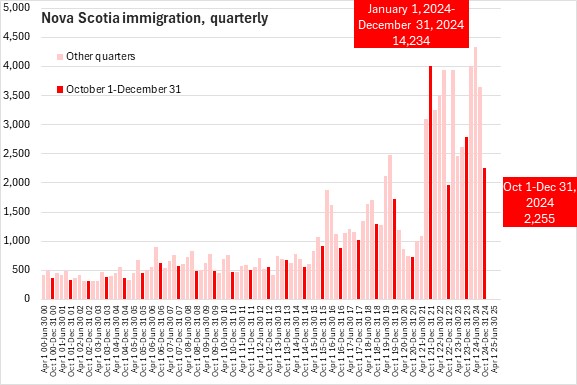
The net change in non-permanent residents in the province was 1,480 persons leaving Nova Scotia's population between October 1 and December 31. The number of non-permanent residents arriving in Nova Scotia was 3,199 while 4,679 non-permanent residents left the province over the same time. The net outflow of non-permanent residents was the strongest fourth quarter outflow on record (last time was 2021) and the second strongest of any period (Q3 2020 was the strongest).
In the period January 1 to December 31, 2024 there was a net increase of 183 non-permanent residents in Nova Scotia with 18,313 non-permanent resident entries and 18,130 non-permanent resident exits.
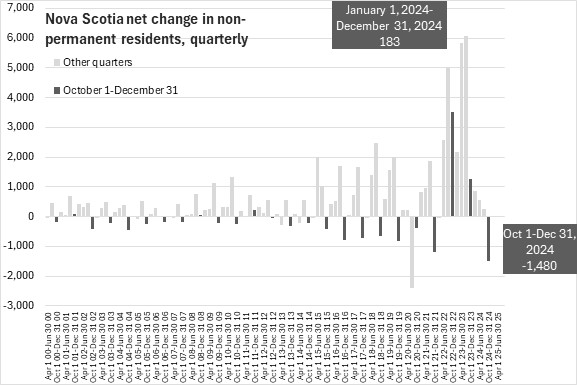
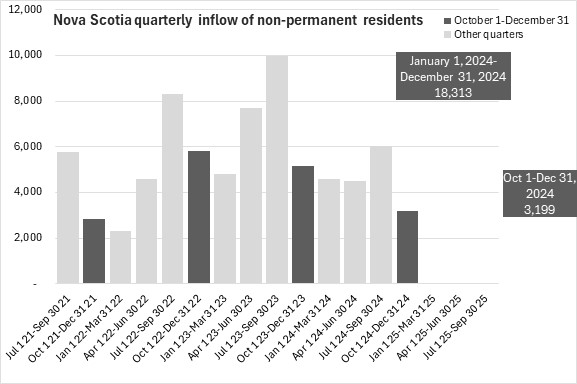
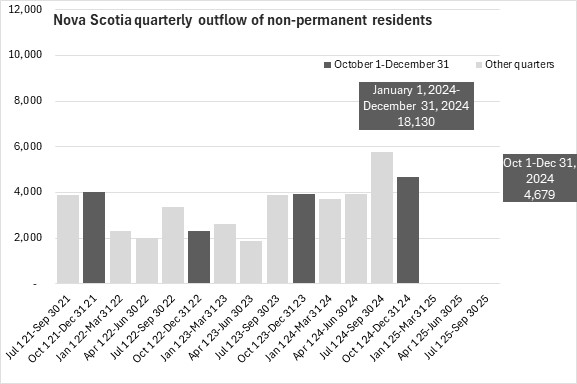
A total of 2,776 new Nova Scotians arrived in the province from other parts of Canada between October 1 to December 31, 2024. This was a slower pace of in-migration than observed during the same months of 2019, 2021, 2022 and 2023. From January 1 to December 31, 2024, 19,071 interprovincial migrants arrived in Nova Scotia.
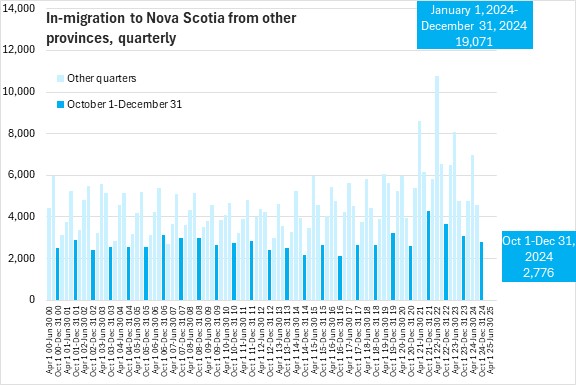
A total of 2,432 Nova Scotians left the province bound for other parts of Canada between October 1 and December 31. This remains elevated from out-migration reported in the same months of the year from 2014 to 2023, with the exception of 2022 when out-migration was slightly stronger. Over the past year, Nova Scotia has seen 17,158 interprovincial outmigrants.
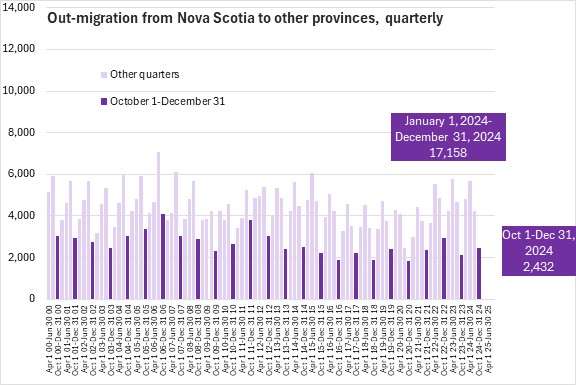
From October 1 to December 31, Nova Scotia's net interprovincial migration generated a net inflow of +344. From January 1 to December 31, 2024, Nova Scotia's net interprovincial migration was positive (+1,913). With slowing in-migration, Nova Scotia's net interprovincial migration flows have decelerated in the last two years.
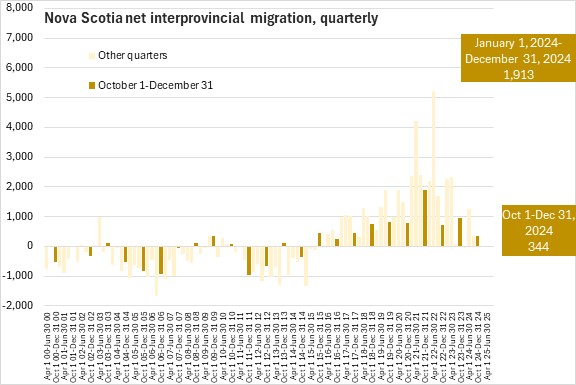
Ontario continues to account for the largest number of in-migrants to Nova Scotia, however this pace slowed substantially from the pace observed in 2021 and 2022.
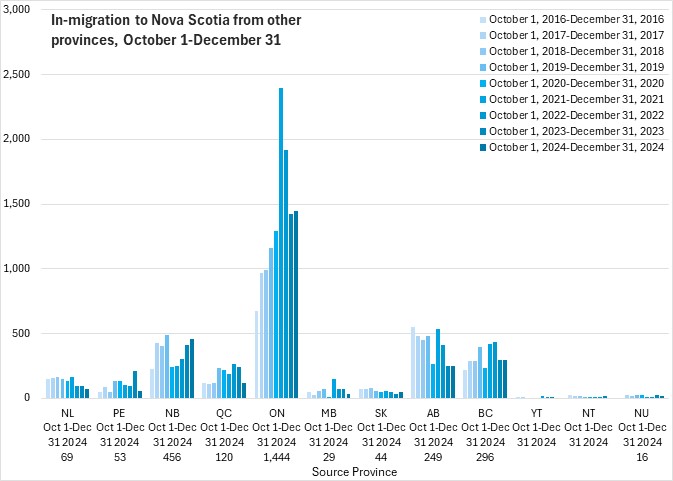
Ontario and Alberta were the largest destinations for those leaving Nova Scotia between October 1 and December 31 of 2024. Out-migration was up to Ontario but down to Alberta, compared to the same months in 2023.
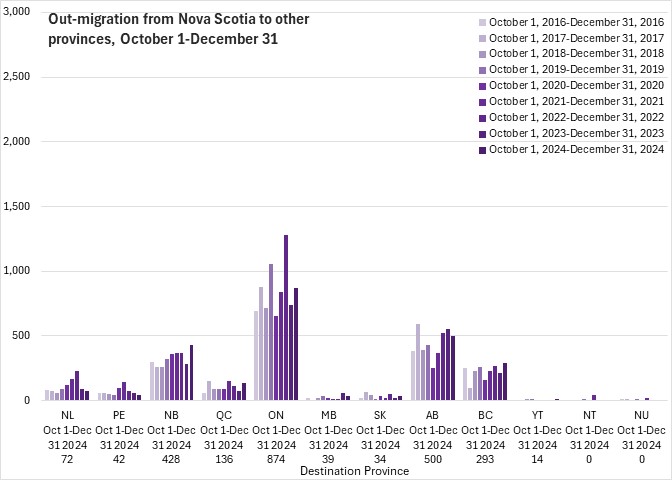
From October 1-December 31, Nova Scotia's net interprovincial population gain reflected net inflows from Ontario (+570), with smaller net inflows from New Brunswick (+28), Prince Edward Island (+11), Saskatchewan (+10), British Columbia (+3) and the Territories (-2) offset by outflows to Alberta (-251), Québec (-16), Manitoba (-10), and Newfoundland and Labrador (-3)
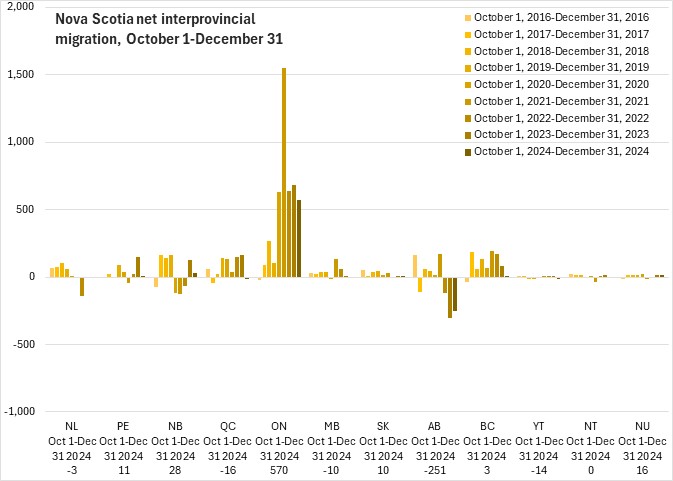
From January 1 to December 31, 2024, the largest source of interprovincial in-migration was from Ontario (8,937), which was lower than in any of the previous three years. In-migration was lower from all provinces and territories compared to the previous year except for Newfoundland and Labrador, Prince Edward Island, Saskatchewan, the Northwest Territories and Nunavut.
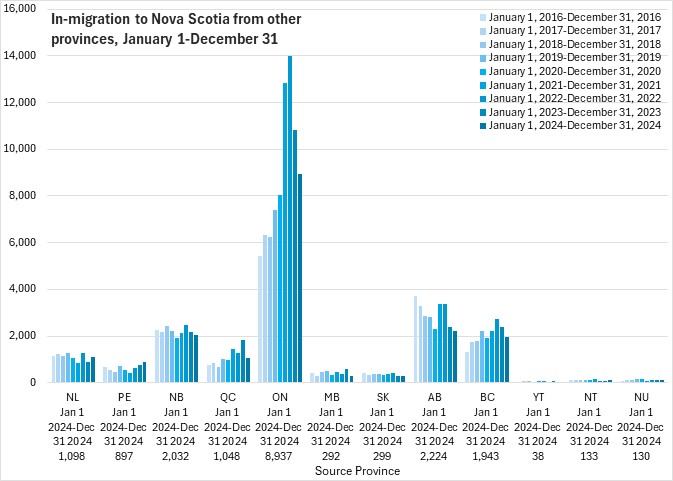
From January 1 to December 31, 2024, the primary destinations for outmigration from Nova Scotia were Ontario and Alberta, followed by New Brunswick and British Columbia. Compared to the previous year, Nova Scotia out-migration increased for seven of the provinces and territories, while out-migration decreased to Newfoundland and Labrador, Ontario, Prince Edward Island, Yukon and the Northwest Territories.
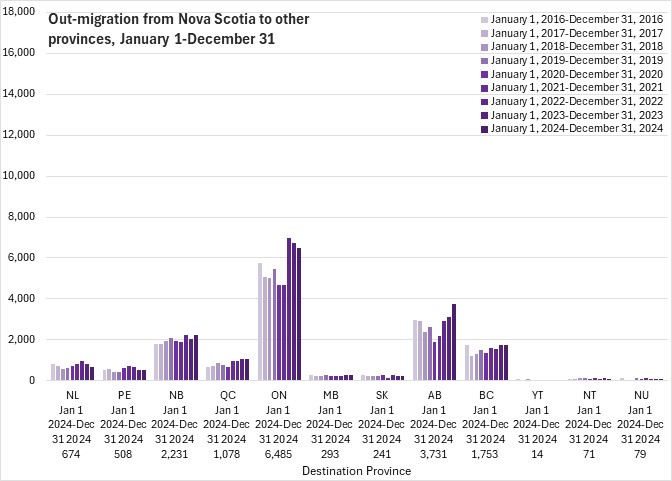
Ontario contributed the most substantial positive net interprovincial migration From January 1 to December 31, 2024 (+2,452), followed by Newfoundland and Labrador (+424), Prince Edward Island (+389), and British Columbia (+190). There were smaller net inflows from Saskatchewan and each of the territories. Alberta (-1,507) and New Brunswick (-199) bound migrants reflected the majority of net outflows, followed by Québec and Manitoba.
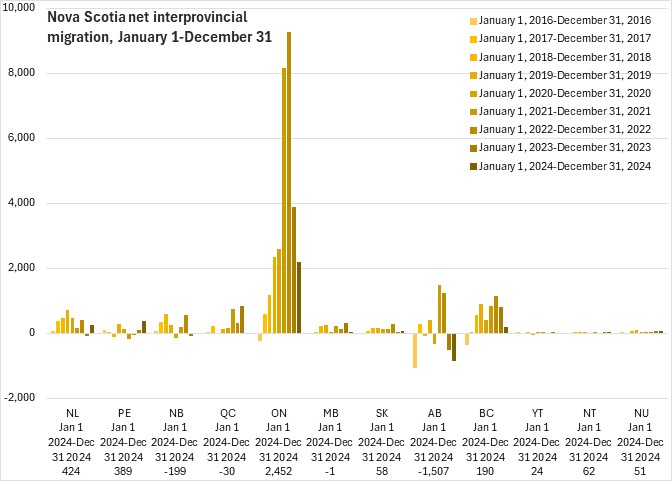
Non-permanent residents
The number of non-permanent residents in Nova Scotia has increased from 27,979 as of January 1, 2022 to 54,598 as of January 1, 2025. Non-permanent residents most often hold work permits (28,116), study permits (13,387), or both work and study permits (8,688).
Asylum claimants, both with and without study/work permits, were 898 as of January 1, 2025.
There were 3,509 other non-permanent residents who are typically family members living with permit holders or persons with temporary resident permits.
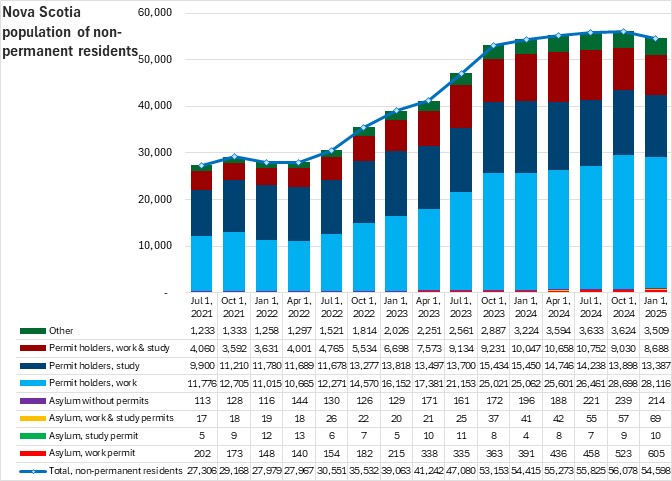
Non-permanent residents accounted for 5.1% of Nova Scotia's population as of January 1, 2025. Nationally, non-permanent residents make up 7.3% of the population with the highest shares in British Columbia (9.3%) and Ontario (8.3%) and lowest shares in Newfoundland and Labrador (3.2%) and Saskatchewan (3.7%).
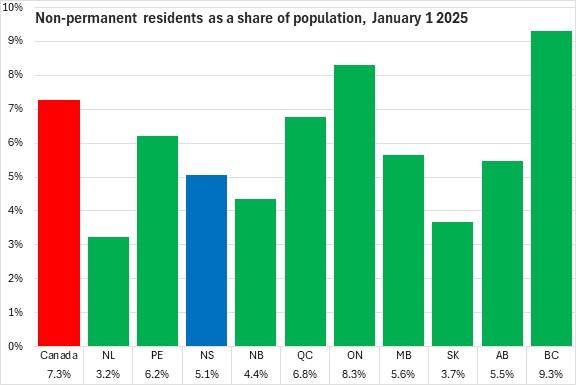
For the period October 1 to December 31, 2024 the non-permanent resident population in Nova Scotia fell 2.6%. Nationally, the non-permanent resident population was down 0.9% with declines in Atlantic Canada, Ontario and British Columbia. The Prairie provinces and Québec reported growth in non-permanent residents during this period, with the fastest growth in Saskatchewan and Alberta.
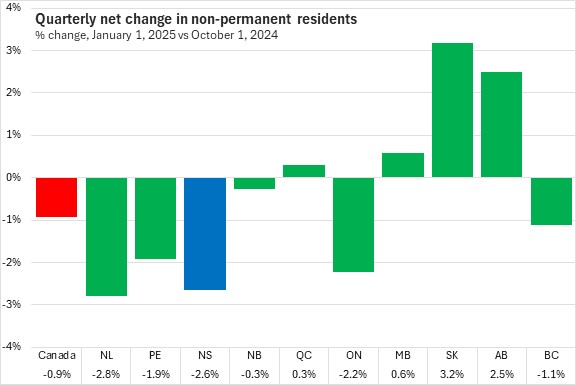
The non-permanent resident population in Nova Scotia has increased 0.3% from January 1 to December 31, 2024. Nationally, the non-permanent resident population increased 10.7% with the fastest growth in Alberta. Prince Edward Island (-4.6%) was the only province to report a decline while Nova Scotia reported the slowest growth among provinces with rising non-permanent residents.
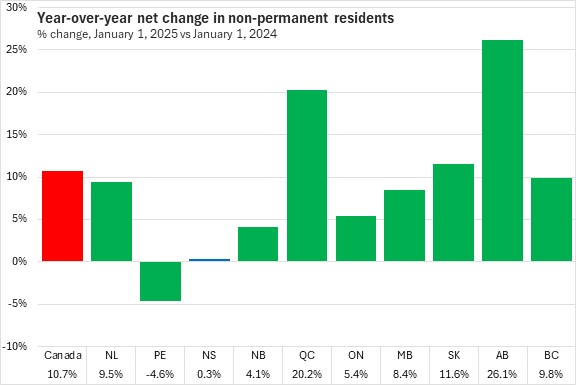
Source: Statistics Canada. Table 17-10-0009-01 Population estimates, quarterly; Table 17-10-0020-01 Estimates of the components of interprovincial migration, quarterly; Table 17-10-0040-01 Estimates of the components of international migration, quarterly; Table 17-10-0045-01 Estimates of interprovincial migrants by province or territory of origin and destination, quarterly; Table 17-10-0121-01 Estimates of the number of non-permanent residents by type, quarterly
<--- Return to Archive